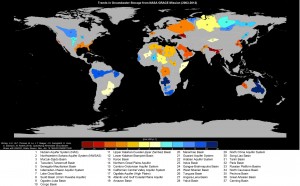How Much Longer Will We Take Water for Granted?
Mar 31st, 2016 | By admin | Category: Water IssuesBy Suzanne York.

Woman collecting water in Phulakhrara village, India [Photo credit: waterdotorg at https://www.flickr.com/photos/waterdotorg/19365390491/]
Worldwide, some 650 million people in the world still do not have access to clean water and more than 2.3 billion do not have access to basic sanitation. Truly, this is morally unacceptable in the 21st century, with all of our global wealth, technology and knowledge.
India, China and Nigeria have the highest numbers of people waiting for access to clean water. And that access is becoming more difficult in the face of other serious issues.
It’s not just a climate change issue”
WaterAid notes “…water resources are becoming increasingly fragile as populations grow, land use changes and deforestation continues. These threats will be exacerbated by the effects of climate change and have a disproportionately large impact on poor people without a safe, reliable water supply.”
Less than 3 per cent of the world’s water is fresh (drinkable), of which 2.5 per cent is frozen in the Antarctica, Arctic and glaciers. Humanity must therefore rely on 0.5 per cent for all of man’s ecosystem’s and fresh water needs. The increasing severity of climate impacts is resulting in more stress on water systems. The UN estimates that at least one in four people will live in a country with chronic or recurring shortages of fresh water by 2050.
A study on water stress just published by MIT found that it’s not only climate change contributing to water issues, but also economic and population growth on top of climate change could lead to serious water shortages across a broad swath of Asia by the year 2050 (emphasis added).
Adam Schlosser, a senior research scientist and deputy director at MIT’s Joint Program on the Science and Policy of Global Change and a co-author of the study, said “It’s not just a climate change issue. We simply cannot ignore that economic and population growth in society can have a very strong influence on our demand for resources and how we manage them. And climate, on top of that, can lead to substantial magnifications to those stresses.”
Contributing Factors
India is highlighted by WaterAid as the worst in the world for the number of people without safe water – nearly 76 million people lack access to safe water. Many have to rely on water tankers to purchase clean water. Poor management of water resources is cited as the main reason for the unavailability of safe water, but depleted aquifers are also a contributing factor. Aquifers provide 85% of drinking water but levels are falling in 56% of the country.
About one third of Earth’s largest groundwater basins are being rapidly depleted by human consumption. Depletion of aquifers is a serious problem not just in India, but also in China and the U.S, especially in the West.

Groundwater storage trends for Earth’s 37 largest aquifers from UCI-led study using NASA GRACE data (2003 – 2013) [Image credit: UC Irvine/NASA/JPL-Caltech]
California has made a dent in its five-year drought, thanks to El Niño rains this season, but nearly 90% of the state is still stuck in a historic drought. And for many years, Californian aquifers have been overpumped faster than nature can replenish them. The state’s agriculture industry is considered breadbasket to the world, so the implications of water scarcity are enormous.
Elsewhere, Texas gets almost 60 percent of its water from groundwater; in Florida, groundwater supplies more than 90 percent of the state’s freshwater. In these three states, population growth and agriculture (namely irrigation) are placing greater demand on limited aquifer resources. These are the three most populous states in the U.S.
Then there the impact on other species. In our anthropocentric society, nature is often missing from discussions on water. What is the effect on other species when a river dries up or is polluted, or a once in a hundred years flood starts happening more and more often? But nature is really not on our radar, except to the extent that she simply provides this precious resource for most of us.
Back to the water equity issue for people, the good news is that there are many groups working to improve access to clean water (see Global Women’s Water Initiative), and others trying to help farmers, municipalities and citizens use water more efficiently via rainwater harvesting, drip irrigation, or recycling wastewater.
And at the United Nations last September, 193 member states adopted the Sustainable Development Goals, “a set of goals to end poverty, protect the planet, and ensure prosperity for all.” Goal 6 is to ensure access to water and sanitation for all.
Our Challenge
Access to water and protecting water sources will be a huge challenge.
A recent BBC News article focused on the water crisis in India and the receding waters of the holy Ganges. A power station official was quoted as saying “We are being told that water levels in the Ganges have declined by a fourth. Being located on the banks of one of the world’s largest rivers, we never thought we would face a scarcity of water. The unthinkable is happening.”
Sadly this is a fitting quote for so many places around the world, as rivers and aquifers dry up. It’s human nature to think “this can’t happen here” but it can, and it is.
Suzanne York is Project Director of Transition Earth.
